Hot Guns on a Cold Bay
The waterfowling action heats up in early fall across this windswept tip on the Alaska Peninsula
The waterfowling action heats up in early fall across this windswept tip on the Alaska Peninsula

Story and Photos by Ron Spomer
"From the left! Two from the left!" shouted guide Jeff Wasley, who was tucked behind a tundra bank attempting to shelter himself from the gale-force winds gusting up to 70 miles per hour. I saw a pair of dark, unidentifiable birds rip downwind over the tortured lake. But by the time I got my Benelli 12-gauge to my face, they were well out of gunning range.
"Those were buffleheads," Wasley superfluously informed me.
"Looked like black ducks to me," I said.
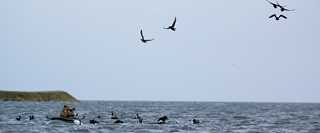
We had been battling the wind since dawn. We had to force open the truck doors, lean into the blast, and then lurch our way over the spongy tundra to the lake. Had the wind suddenly quit, we'd have fallen on our faces. And now the rain splattering my eyeglasses made everything flying look like black duckseven the ravens.
"Why are ravens flying on a day like this?" I asked.
"It's Alaska. If they waited for good weather to hunt, they'd starve," Wasley yelled back. "Here comes a . . . there went a goldeneye!"
Wasley isn't one to wait around for ideal weather, either. Like the birds he pursues, this waterfowl biologist turned professional hunting guide ventures afield under any conditions. He goes with a can-do attitude to savor the wide, wild world while he can. It's infectious. With Wasley driving the agenda, you dress and go, appreciating that this is your heritage as a hunter-gatherer. You only get one ride on this merry-go-round, so you might as well go for the gusto.
Six of us were doing just that in Cold Bay, Alaska, last fall. We had come to the tip of the Alaska Peninsula near the Aleutian Islands to put Benelli's new highly anticipated Super Black Eagle 3 through a kind of trial by fire as we pursued the region's bounteous ducks and geese. The original SBE, which was launched in 1991, was the first autoloader to handle everything from 2 3/4- to 3 1/2-inch shells. This third-generation model was engineered to be the best yet, and we would be among the first to put it through its paces.
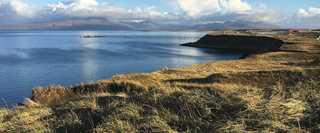
The next day, assistant guide Mark Vander Zanden told me to "just stay low" as I settled into a quarter inch of water in his fiberglass layout boat. The boat looked like a pumpkin seed and was littered with Hevi-Shot hulls and one soggy shell box. "Jeff will start taking the other guys back, and when you limit out we'll pack up the rest of this gear and head in. But take your time. Just call them like you were doing earlier. Enjoy. I'll be watching," my guide added, before heading back to shore to supervise the action.
Despite having a half century of waterfowl hunting in my rearview mirror, this was my first experience in a layout boat. The wind was rising, but it was a zephyr compared to the previous day's gale. The sun was shining and I was plenty warm in my rain jacket and light parka. My gloves were off. Cold Bay, indeed!
The lap of the water lulled me, but waves of cackling Pacific brant interrupted that soon enough. Flocks of dozensno, hundredswere rising and settling in the distance. Some broke away. My way. Oh, shoot! Here they come. Come on! Come on! I slid down lower in the boat, watching the approaching flock over the Benelli. I flexed my trigger hand around the grip and crooked my index finger onto the oversized safety.
The flock veered west, still out of range, but trailing them came a band of brothers, wings swept back in the wind, pumping buoyantly, all black, low to the water. I yipped and yapped in my best falsetto brant barks, and it appeared the birds bought it. Delicious anticipation. This is the part I like best, and it can be fully appreciated only when hunting solo. You let them come . . . and let them come. No need to worry about appearing selfish by shooting before anyone else. No worrying about seeing the bird you picked tumble an instant before you slap the trigger. Just savor the suspense. Let the tension build and then . . .
When I sat up, two birds flared and turned broadside. They seemed to hang against the blue sky, white-barred flanks and necklaces shining in the sun, dark eyes glinting. The gun came up easily, perfectly aligned. Wham! Wham! Each goose cartwheeled into the waves. My first two shots at brant, ever, and I'd doubled.
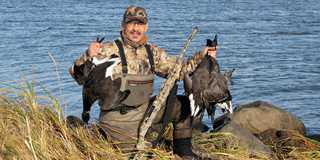
On our third day afield, I found myself sitting on a tundra islanda hill rising 40 feet above Izembek Lagoonsubject to the whims of the weather. There I was, sun-drenched one minute and battered by horizontal rain squalls the next. Two of my buddies were in layout boats 150 yards out in the water. While awaiting my turn, I soaked up what must be the most spectacular scenery in all of waterfowling.
To the west, the unforgiving Bering Sea battered the curve of the Alaska Peninsula. Walls of white water rose and crashed violently on a barrier beach. To the east, two strings of brant decoys and two layout boats bobbed in the water, heads and gun barrels protruding. Beyond the hunters loomed snow-mantled Mount Pavlof, volcanic smoke drifting from its 8,200-foot peak. The Aghileen Pinnacles towered nearby, their black, jagged spires an ominous counterpoint to the snowy volcano. To the southwest, the massive snow cone of the Shishaldin Volcano puffed 9,372 feet above the sea. And all around me, submerged beneath the wind-whipped waters, was one of the largest eelgrass beds in the world. That's why the brant were there. Nearly the entire world population of 150,000 Pacific brant fatten on Izembek Lagoon's extensive eelgrass before fleeing south to the Gulf of California and from where I sat, it seemed as if I could see most of them. Dark flocks bobbing in the waves. Skeins rising and dropping, flying to better feeding sites, winging close enough to convince us that this is the finest goose hunting in the world.
Oddly enough, I hadn't come to Cold Bay for the geese. I'd come for the sea ducks. Harlequins. Surf, black, and white-winged scoters. Long-tailed ducks and Pacific common eiders. These were the colorful, exotic species that had lured me away from the Lower 48 during the heart of the pheasant, quail, partridge, and whitetail seasons.
From the perspective of a farm kid raised on the edge of the prairie, sea ducks had always seemed too exotic, too remote, too foreign. I had never imagined that I'd get the chance to pursue them. Yet there I was, on our fourth day with Wasley's Four Flyways Outfitters, bobbing in the Pacific in a two-man rubber raft three miles from shore with whales and sea lions swimming beneath me and a string of eider decoys rolling on the water's surface. The sky was blue again. I was surrounded once more by volcanic peaks undefiled by road, pole, tower, or line. The wind had gone elsewhere. Indeed, Cold Bay would have been glassy if not for those pesky ocean swells, which were about to teach me something new about duck shooting.
Two of my friends were gunning from layout boats over their own blocks about 300 yards away. Wasley and Vander Zanden floated nearby in the tender, ready to swoop in and retrieve our birdsor us, if necessary. The action, however, was slow in coming. I'd imagined rocky shores, big winds, rime ice, and black-and-white sea ducks buzzing past, banking hard, fanning their pink feet, and splashing into the stool. Instead, I watched loons and cormorants arrow by. A line of white-headed, blue-bodied emperor geese crossed the bay, their calls as tiny as their bills. A bald eagle swooped and harassed something over the water, and a knot of rock sandpipers zipped by like a thought. But where were all the sea ducks?
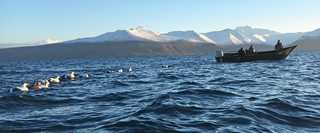
Don't get me wrong. It was a great morning for birding. As isolated as I might have felt there, 12 miles from the World War II airstrip that launched development of the village of Cold Bay, some 600 miles from Anchorage, and 1,800 miles from home, I never lacked for feathered friends. A pigeon guillemot landed daintily on the water near my boat, eyeing me suspiciously. In addition, there appeared to be duck-like birds flashing low to the water in the far distance. I repeatedly flagged to get their attention. Four of them flew in from behind my right shoulder, crossed the decoy string about 35 yards out, and were gone before I realized I'd just missed my first chance to shoot at a harlequin duck. A few minutes later, I hesitated on another bunch and missed my second chance. Then I caught a welcome and familiar call, but only because I'd heard recordings of it. This was a duck ordering breakfast. Ahm, ahm, omelet. Quick, nasal pronunciation of ahm, ahm, ahm-ah-letthe last word three distinct syllables. The long-tailed duck puts emphasis on the last syllable and gives it a rising inflection.
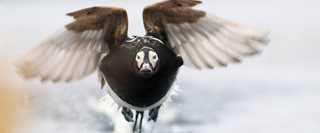
Photo Ken Archer
I spotted the black-and-white birds, six of them, flying about 25 feet above the bay, angling toward my spread, right to left. When they had closed within about 35 yards, I sat up, swung my Super Black Eagle 3, fired twice, and bagged my first two long-tailed ducks, the sea duck equivalent of a pintail.
The Benelli had performed flawlessly. The new detent locking assist borrowed from the company's Ethos shotgun was closing the rotating bolt head every time, whether I slammed it or eased it down. Just a touch at the back of the oversized charging handle activated the detent for a positive lockup that I could feel and hear. I soon discovered a glitch, however. The gun sometimes missed. In fact, it missed on my next four shots. A drake common eider passed right to left, an easy shot. Bang bang. Nothing. Then another brace of long-tailed ducks and . . . two more misses. Next a harlequinand a clue. The bird was about 20 feet above the water, but my entire payload had sprayed into a wave.
I knew I was fully capable of missing a passing duckbut by shooting 20 feet below it? While trying to figure out what had gone wrong, I pointed the muzzle at a distant mountain peak and was shocked to see the barrel rise well above it, then dip far below it as my rubber raft rose and fell in the swell. The SBE 3 was exonerated.
There wasn't much I could do but hope that future shots would come between swells. Enough did. By the end of the day, I managed to collect a spectacular Pacific eider drake, a pair of black scoters, and two drake harlequins. All life birds. And all without capsizing.
Ducks Unlimited uses cookies to enhance your browsing experience, optimize site functionality, analyze traffic, and deliver personalized advertising through third parties. By continuing to use this site, you agree to our use of cookies. View Privacy Policy